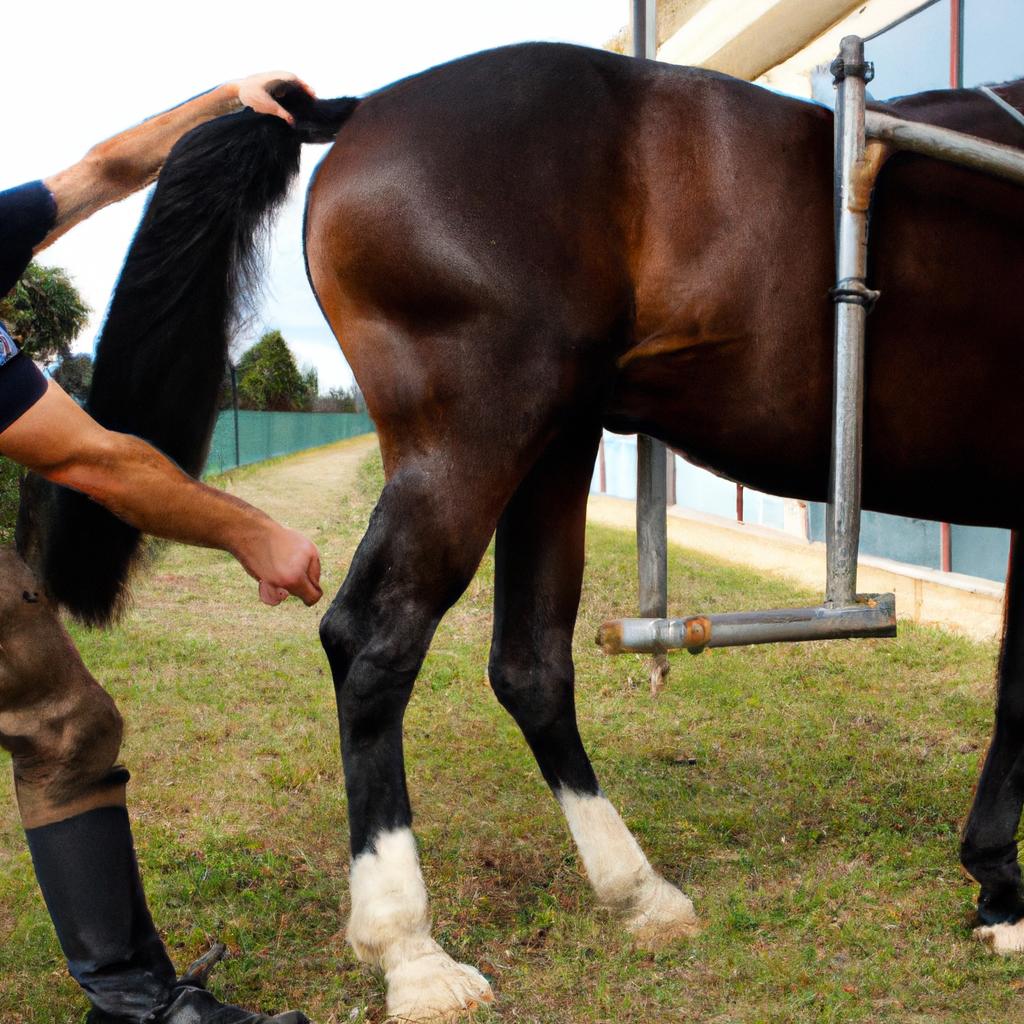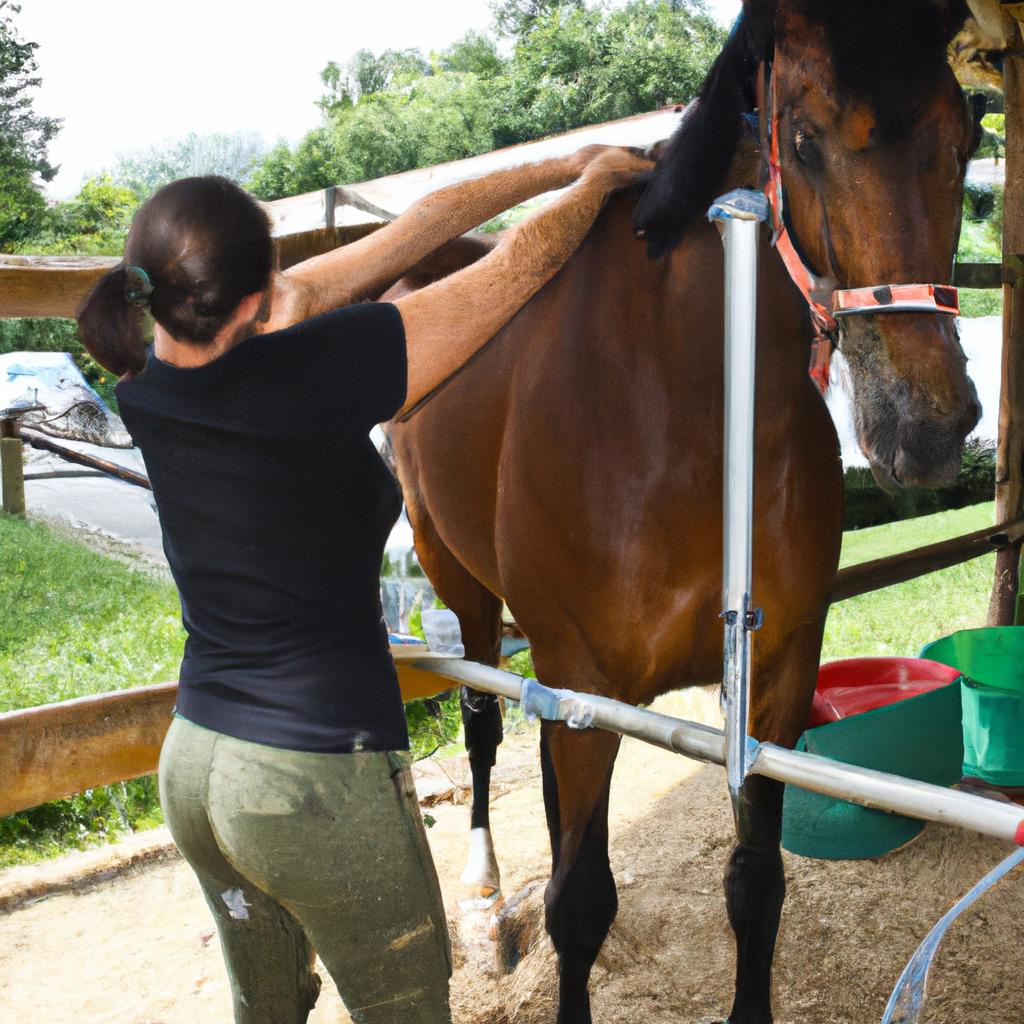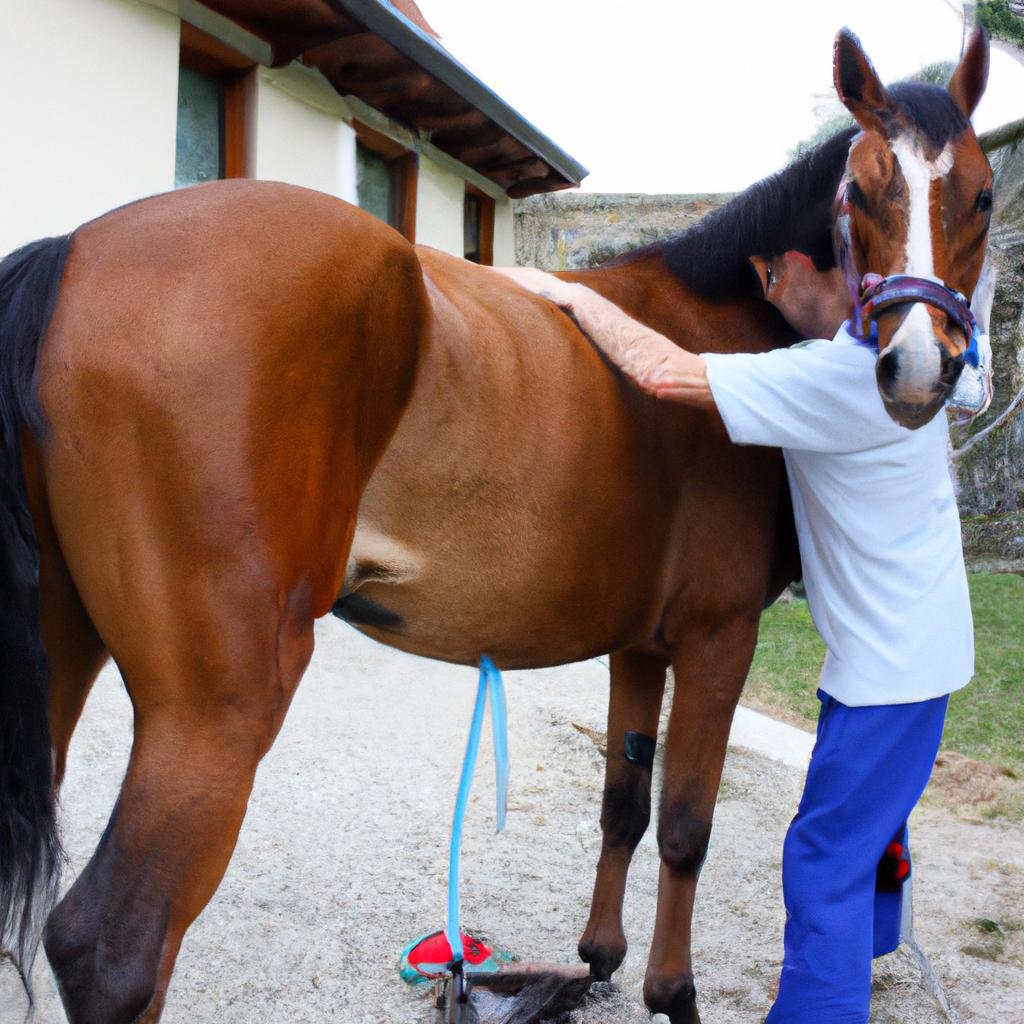The ability to bend is crucial for horses’ overall health and performance. However, just like humans, horses can experience difficulty in bending due to various conditions. This article aims to explore the role of chiropractic care in addressing these issues and treating common conditions that affect a horse’s flexibility.
Imagine a scenario where a competitive dressage horse suddenly starts struggling with its lateral movements during training sessions. The once fluid and graceful transitions become stiff and uncomfortable for both the rider and the horse. This decline in performance could be an indication of underlying musculoskeletal problems affecting the horse’s ability to bend properly. In such cases, seeking chiropractic care may provide significant relief from pain or restrictions that hinder a horse’s range of motion.
Chiropractic treatment focuses on detecting and correcting subluxations, which are misalignments within the spine or other joints that interfere with normal function. By applying gentle adjustments, chiropractors aim to restore proper alignment and joint mobility, aiding in improved flexibility and reducing discomfort associated with bending difficulties. Throughout this article, we will delve into some common conditions treated by chiropractic practitioners when it comes to addressing difficulties in bending among horses.
What is Equine Chiropractic?
What is Equine Chiropractic?
Imagine a horse named Bella who has been experiencing difficulty in bending her neck and back while being ridden. Despite regular exercise and training, Bella’s stiffness continues to hinder her performance. In cases like these, equine chiropractic can play a vital role in addressing the underlying issues and restoring balance and mobility to horses.
Equine chiropractic is a specialized field of veterinary medicine that focuses on diagnosing and treating musculoskeletal disorders in horses. It involves the manipulation of joints, bones, and soft tissues to alleviate pain, restore proper alignment, and enhance overall well-being. This non-invasive approach aims to optimize the nervous system function by ensuring optimal communication between the brain, spinal cord, nerves, muscles, tendons, ligaments, and organs.
The benefits of equine chiropractic care extend beyond simply relieving discomfort or improving athletic performance. Here are some key advantages:
- Enhanced range of motion: By realigning the spine and joints, equine chiropractors can help improve flexibility and range of motion in horses.
- Pain relief: Many musculoskeletal conditions cause pain for horses; however, through targeted adjustments and manipulations, equine chiropractors can provide significant pain relief.
- Improved biomechanics: Correcting postural imbalances allows horses to move more efficiently with improved coordination during various activities such as jumping or dressage.
- Overall wellness: Regular chiropractic care helps maintain optimal health by promoting better circulation, reducing inflammation, enhancing immune function, and supporting general well-being.
| Condition Treated | Symptoms | Benefits of Equine Chiropractic |
|---|---|---|
| Back pain | Stiffness | Relief from discomfort |
| Neck stiffness | Difficulty bending | Restored mobility |
| Lameness | Uneven gait | Improved movement mechanics |
| Muscle tension | Limited range of motion | Enhanced flexibility |
Equine chiropractic can be a valuable adjunct therapy for horses with various conditions, including but not limited to back pain, neck stiffness, lameness, and muscle tension. By addressing these issues at their root cause, equine chiropractors aim to restore proper function and performance in horses.
Transitioning into the subsequent section about “How Does Equine Chiropractic Work?”, it is crucial to understand the mechanisms behind this practice and how it helps horses regain optimal health and mobility.
How Does Equine Chiropractic Work?
Difficulty in Bending: Chiropractic for Horses and Common Conditions Treated
What is Equine Chiropractic?
Equine chiropractic is a specialized form of therapy that focuses on the musculoskeletal system of horses. It involves the manual manipulation of joints, muscles, and soft tissues to restore proper alignment and function. This non-invasive treatment aims to alleviate pain, improve flexibility, and enhance overall performance in horses.
How Does Equine Chiropractic Work?
Equine chiropractors use their hands or specific instruments to apply controlled force to targeted areas of the horse’s body. By doing so, they can correct misalignments (also known as subluxations) that may be causing difficulties in bending or other issues. When these misalignments are addressed, it allows for improved mobility and reduces strain on surrounding structures.
One example where equine chiropractic has shown success is with young racehorses experiencing difficulty in bending during training sessions. In one case study conducted at a racing stable, several two-year-old Thoroughbreds were observed having trouble flexing their necks adequately while turning corners at high speeds. After receiving regular chiropractic treatments over a period of six weeks, marked improvements were noted in their ability to bend smoothly without any signs of discomfort or resistance.
The benefits of equine chiropractic extend beyond just improving bending abilities. Here are some potential positive outcomes:
- Enhanced range of motion
- Increased stride length
- Improved balance and coordination
- Relief from muscle tension and soreness
These advantages contribute not only to better athletic performance but also promote overall well-being for the horse. To illustrate this further, consider the following table highlighting various conditions commonly treated by equine chiropractors:
| Condition | Symptoms | Treatment Outcome |
|---|---|---|
| Back Pain | Stiffness, reluctance to engage hindquarters | Reduced pain and increased suppleness |
| Lameness | Uneven gait, shortened stride | Restored normal movement and improved symmetry |
| Neck Stiffness | Limited flexibility, difficulty bending | Enhanced range of motion |
| Saddle Fit Issues | Resistance under saddle, behavior changes | Improved comfort during riding |
Equine chiropractic plays a crucial role in maintaining the overall health and performance of horses. By addressing misalignments and promoting proper biomechanics, it helps alleviate difficulties in bending as well as other related issues. In the subsequent section, we will explore some common signs that indicate a horse may be experiencing problems with bending.
Signs of Difficulty in Bending
Imagine a scenario where you are riding your horse and notice that it is having difficulty bending its neck or body. This can be concerning as proper flexibility and range of motion are essential for the overall well-being and performance of horses. In this section, we will explore some common signs that indicate difficulty in bending and how chiropractic care can address these issues.
One clear sign of difficulty in bending is when a horse resists turning its head to one side or has limited mobility while doing so. For example, during riding exercises such as circles or lateral movements, the horse may exhibit stiffness or resistance in flexing its neck properly. Additionally, if a horse struggles with maintaining balance while executing turns or changes of direction, it could also be an indication of underlying problems with spinal alignment and joint function.
To further understand the signs associated with difficulty in bending, let’s consider a few key indicators:
- Uneven stride length: When a horse experiences challenges in bending, it may result in an unevenness in their stride length. This can affect their gait and overall movement.
- Decreased performance: Horses rely on efficient biomechanics for optimal performance. If they have trouble flexing their bodies appropriately, it can hinder their ability to perform at their best.
- Behavioral changes: Pain or discomfort caused by difficulties in bending can lead to behavioral changes such as irritability, resistance to training cues, or reluctance to engage in certain activities.
- Muscle tension or soreness: Tight muscles along the back and hindquarters are often observed when horses struggle with bending-related issues. These tense areas can indicate musculoskeletal imbalances that need attention.
It is important to note that these signs do not necessarily confirm any specific condition but rather serve as potential red flags indicating the need for further evaluation by a qualified equine chiropractor.
By addressing these signs promptly through chiropractic care tailored specifically for horses, various conditions can be effectively managed and treated. In the subsequent section, we will delve into the benefits of chiropractic care for horses and how it can help promote overall well-being and performance in these magnificent animals.
Benefits of Chiropractic Care for Horses
Signs of Difficulty in Bending and the Benefits of Chiropractic Care for Horses have shed light on the importance of addressing this issue in equines. To further understand the impact of chiropractic care, let us explore some common conditions treated by equine chiropractors.
One example that highlights the effectiveness of chiropractic care is a case involving a 10-year-old Thoroughbred mare named Bella. Bella had been experiencing difficulty bending to the left, which was hindering her performance as an eventing horse. After several sessions with an equine chiropractor, who performed adjustments along her spine and pelvis, Bella’s flexibility significantly improved. She regained full range of motion in her neck and back, allowing her to navigate tight turns and jumps more effortlessly.
Equine chiropractors specialize in treating various musculoskeletal issues that can affect a horse’s ability to bend properly. Some common conditions addressed through chiropractic care include:
- Misalignments: Subtle misalignments within the spinal column or pelvis can impede normal movement patterns and lead to stiffness when bending.
- Muscle imbalances: Tension or weakness in specific muscle groups can hinder a horse’s ability to flex properly during bending movements.
- Joint restrictions: Restricted mobility within joints such as the poll, neck vertebrae, or sacroiliac joint can limit a horse’s flexibility while bending.
- Soft tissue injuries: Strains or sprains in ligaments, tendons, or muscles may cause pain and restrict a horse’s ability to bend comfortably.
To better visualize how these conditions manifest and are treated, consider the following table:
| Condition | Symptoms | Treatment |
|---|---|---|
| Misalignments | Stiffness during bending | Spinal adjustments |
| Muscle imbalances | Uneven gait | Rehabilitation exercises targeting |
| weak or overactive muscles | ||
| Joint restrictions | Limited range of motion during bending | Manual joint mobilization techniques |
| Soft tissue injuries | Lameness, swelling, heat in the affected | Rest, cold compresses, physical therapy |
| area |
This table provides a concise overview of some common conditions treated by equine chiropractors and the corresponding symptoms and treatment options. Through targeted adjustments, exercises, and other therapeutic interventions, these professionals aim to alleviate pain, restore normal function, and enhance overall performance.
By addressing these conditions with chiropractic care, horses can experience improved flexibility and movement capabilities. In our subsequent section on “Conditions Treated by Equine Chiropractors,” we will delve deeper into specific ailments commonly seen in horses and how chiropractic treatment plays a vital role in their management.
Conditions Treated by Equine Chiropractors
H2: Difficulty in Bending and Common Conditions Treated
Imagine a scenario where a horse, despite their naturally flexible spine, experiences difficulty bending or turning. This can be caused by various factors such as poor conformation, muscle imbalances, or joint stiffness. In these cases, equine chiropractic care can provide significant benefits to address this issue. By realigning the horse’s musculoskeletal system through manual adjustments, chiropractors aim to improve range of motion and alleviate discomfort. Let us now explore some common conditions that are often treated by equine chiropractors.
Equine chiropractic care is particularly effective in addressing the following issues:
-
Muscle Imbalances: Horses engage different muscles during various activities such as jumping or dressage training. Over time, this may lead to muscular imbalances and tension within the body. Chiropractic adjustments help rebalance these muscles and promote better coordination, enhancing overall performance.
-
Sacroiliac Joint Dysfunction: The sacroiliac (SI) joint connects the pelvis to the spine and plays a crucial role in transferring forces between the hind limbs and the rest of the body. When this joint becomes misaligned or inflamed, it can result in pain and decreased mobility. Through targeted adjustments, equine chiropractors work on restoring proper alignment of the SI joint.
-
Neck and Back Pain: As with humans, horses can also experience neck and back pain due to stress, trauma, or repetitive strain injuries from strenuous activities like racing or pulling heavy loads. Chiropractic care helps relieve tension in these areas by identifying spinal misalignments and gently correcting them.
-
Lameness Issues: Lameness is a condition characterized by an abnormal gait or movement pattern in horses. It can stem from issues such as joint problems, ligament damage, or foot-related abnormalities. Equine chiropractors focus on improving biomechanics through spinal manipulations which can indirectly address underlying lameness issues.
To further illustrate the significance of chiropractic care in treating these conditions, consider the following table:
| Condition | Symptoms | Chiropractic benefits |
|---|---|---|
| Muscle Imbalances | Uneven muscle development | Restores balance and coordination |
| Sacroiliac Dysfunction | Hind limb lameness/pain | Improves joint alignment and mobility |
| Neck and Back Pain | Stiffness, reluctance to bend | Relieves tension and improves flexibility |
| Lameness Issues | Abnormal gait or movement patterns | Enhances overall biomechanics |
As veterinary medicine continues to evolve, equine chiropractic care has gained recognition as a valuable treatment option for various musculoskeletal conditions. The ability to restore proper alignment through targeted adjustments makes it an effective complementary therapy alongside traditional veterinary approaches.
Choosing a Qualified Equine Chiropractor
Equine chiropractic care is a specialized form of treatment that focuses on the manipulation and adjustment of the musculoskeletal system in horses. It offers numerous benefits, particularly for addressing various conditions that can affect equines. One such condition commonly treated by equine chiropractors is difficulty in bending. This section will explore this specific issue and shed light on how chiropractic intervention can help.
To better understand the significance of chiropractic care for horses experiencing difficulty in bending, let us consider an example scenario: A competitive show jumper starts showing signs of resistance when asked to bend around corners during training sessions. The horse’s movements become stiff, and it struggles with maintaining balance while attempting tight turns. In this case, an equine chiropractor would examine the horse’s spine and joints to identify any misalignments or restrictions that could be causing the problem.
There are several reasons why horses may experience difficulty in bending, including:
- Muscular imbalances: Imbalances in the muscles surrounding the spinal column can hinder proper movement.
- Joint stiffness: Stiffness within the joints can limit their range of motion, making bending challenging.
- Spinal misalignments: Misaligned vertebrae can disrupt nerve function and impede flexibility.
- Soft tissue injuries: Strains or tears in ligaments or tendons can lead to pain and restricted mobility.
To illustrate these points further, consider the following table outlining common conditions related to difficulties in bending:
| Condition | Description | Symptoms |
|---|---|---|
| Muscle imbalance | Uneven muscle development or tension affecting lateral bending | Stiffness, resistance to turning |
| Arthritis | Inflammation and degeneration of joint cartilage | Pain, swelling, reduced flexibility |
| Sacroiliac | Dysfunction involving the sacrum and ilium | Difficulty engaging hindquarters, uneven movement, discomfort |
| Neck stiffness | Restricted motion in the neck region | Difficulty flexing laterally or rotating head and neck smoothly |
As evident from this table, these conditions can significantly impact a horse’s ability to bend properly. Equine chiropractors employ various techniques such as spinal adjustments, soft tissue mobilization, and stretching exercises to address these issues effectively.
In summary, difficulty in bending is a common problem that horses may face due to muscular imbalances, joint stiffness, spinal misalignments, or soft tissue injuries. Equine chiropractic care plays a crucial role in identifying and treating such conditions by employing targeted interventions tailored to each individual horse’s needs. By addressing the underlying causes of difficulty in bending, equine chiropractors help restore proper functionality and improve overall performance.
 Eq Muscle Release
Eq Muscle Release



